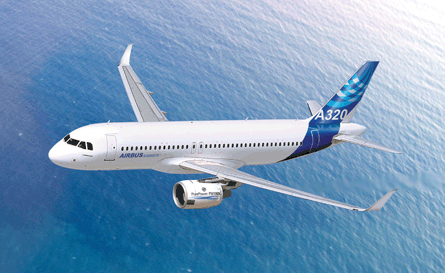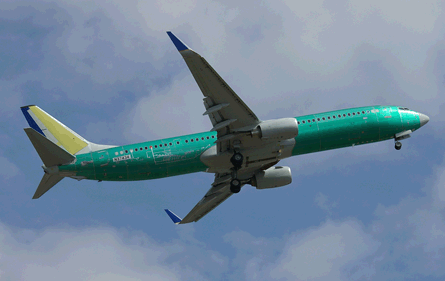Although pressure has been mounting on Airbus and Boeing to move forward with their plans for single-aisle replacement designs, the rivals have been more concerned with developing their current programmes.
This is no surprise, given that between them, they have an order backlog for around 4,500 narrowbodies, split roughly 50/50, which at current rates will keep production running until 2015. But a new rival from Bombardier, the Pratt & Whitney PW1000G GTF-powered CSeries small airliner, is threatening the bottom end of the two established single-aisle families.
Boeing - in conjunction with CFM International - has upped the ante this year, rolling out a wide-ranging 737 upgrade package to boost performance and cabin comfort. Airbus, meanwhile, continues to make incremental improvements to the A320 family, addressing weight reductions and operating weight increases amid ongoing studies of a winglet programme.
 |
|---|
© Tim Bicheno-Brown/FlightglobalAirbus is evaluating a re-engined A320 which could look something like this |
Both programmes have reached important milestones this year, with Boeing delivering the 6,000th 737 (a 737-800 for Norwegian Air Shuttle, which was also the 2,868th 737 NG delivered), and Airbus handing over its 4,000th A320 family aircraft - an A319 for TAM. During the third quarter, Boeing also quietly shipped its 3,000th Next Generation 737.
The 737 performance improvement package (PIP) will arrive in mid-2011, delivering about a 2% cut in fuel burn on longer stages. It comprises the CFM56-7B Evolution powerplant providing a 1% improvement in overall aircraft efficiency, and a minor clean-up of the airframe's aerodynamics giving a further 1% gain.
EVOLUTION FLIGHT TRIALS
Flight trials of the CFM56-7B Evolution nacelle began in the number one (left-hand) position of a 737-900ER in August, with the test engine featuring a longer nacelle than the standard -7B.
Ahead of the PIP, a new cabin, dubbed the Sky Interior, will be introduced including features such as larger 777/787-style pivot bins, sculpted sidewalls and revised windows. The new interior, which Boeing hopes will deliver a 2-4dB cut in cabin noise, is due to enter service with FlyDubai in the fourth quarter of 2010.
Although Airbus views the 737 package as a catch-up move by its rival, it confesses that it is "talking with CFM" to see what of the CFM56-7B Evolution package is transferable to the A320's CFM56-5. Unlike the 737, however, the A320 models (except the A318) are also offered with the International Aero Engines V2500, meaning that Airbus will need to encourage both parties to pursue engine upgrades to ensure performance parity across the family.
With the 2,400 aircraft on backlog representing over six years of production, Airbus expects output will run for at least another decade and ultimately deliver more than 8,000 aircraft.
 |
|---|
© Joe WalkerFlight trials of the CFM56-7B Evolution nacelle began in the number one (left-hand) position of a 737-900ER in August |
While Airbus has not announced any major new upgrade in response to the 737 PIP, an ongoing airframe weight saving effort should trim 250kg off A320s delivered from 2010, while more aerodynamic cleaning up means that aircraft delivered from January 2009 have a 1% improvement in drag standard.
This year, approval was given for an optional 1t increase in MTOW, achieved through a software upgrade to the flight-control system, which is retrofittable to A320-200s from MSN1903 (a 2002-delivered aircraft) onwards. The higher weight provides around 280km (150nm) additional range or a payload increase equivalent to 10 passengers.
An innovative new use for an A320 variant began in September when British Airways inaugurated A318 transatlantic services from London City airport to New York. To gain approval for operations into the tight London City runway, Airbus has developed changes to the flight controls on approach that are activated by a switch in the overhead panel. This allows the aircraft to have a different aerodynamic braking system for approach and touchdown.
Airbus is staying quiet on its plans for an A320 winglet programme after completing another round of test flights this year. However, Airbus sources say that it has decided to go ahead with a programme, but is yet to finalise whether to adopt Aviation Partners' design or its own "sharklet" device.
Looking towards the long term, there is little enthusiasm on either side of the Atlantic to move forward with all-new replacements, as neither airframer can yet see the requisite quantum leaps in airframe and engine technology.
Airbus's chief salesman John Leahy is confident that A320 and 737s will still be in production a decade from now, although concedes that this could be with "a different engine".
All the big-three engine makers have suitable new technology programmes under way. P&W leads the pack with its geared turbofan, which is due to enter service in 2013 on the Mitsubishi MRJ regional jet and the CSeries. CFM International is developing the Leap X turbofan/open rotor for service readiness from 2016, while Rolls-Royce is exploring developments.
Airbus is expected to decide whether to launch a re-engining upgrade for the A320 before the end of 2010 for a service entry in around 2015, with the GTF seen as a leading candidate. Boeing chief executive Jim McNerney has said he believes a re-engined narrowbody is viable in the near term and that a derivative re-engined 737 would cost in the range of 20-30% of a full development programme.
As a result, he says, "the re-engine case is stronger than I anticipated it would be, which doesn't mean that's what we'll decide". CFM has indicated it could accelerate the Leap X schedule - set for certification in 2016 - should it be selected to power China's new C919 airliner, which would open the door for Boeing to consider the engine for any 737 upgrade.
One of the drivers behind the two rivals' reluctance to be the first to blink is that their sales performance in the sector is fairly evenly matched. Last year, Airbus racked up 472 A320 family orders, and delivered 386 aircraft, while Boeing's 737 sales stood at 484 and deliveries at 290 (strike affected). In 2009 the 737 has a slight edge on its rival at the nine-month point with 71 net orders against 47 for the A320.
Deliveries are evenly matched, with Airbus having shipped 290 single-aisles and Boeing 280. Included in the Airbus shipments is the first A320 off the new Chinese assembly line in Tianjin, which is ultimately expected to produce four single-aisle aircraft a month.
Source: Flight International























